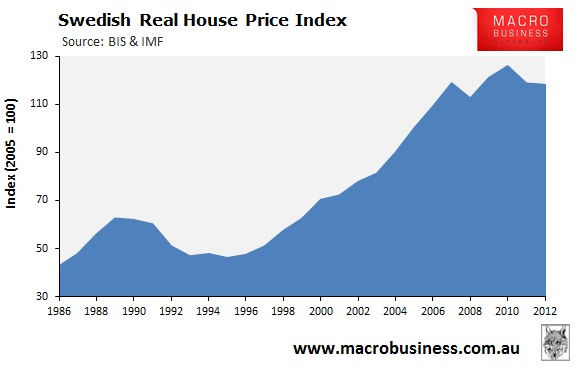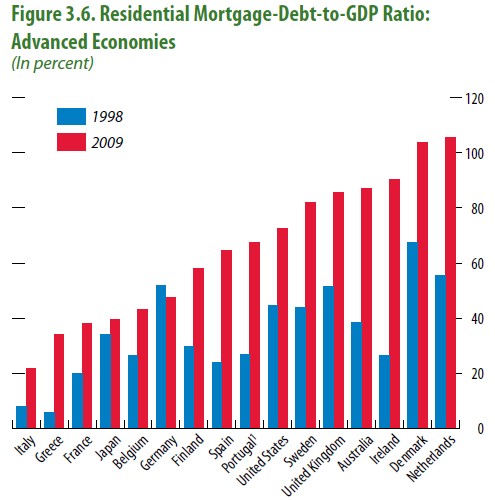
Sweden’s housing market shares a lot of simularities with Australia.
As was the case in Australia, Sweden’s financial system was deregulated in the mid-1980s, which led to a house price boom and then corrrection as the Swedish economy entered recession in the early-1990s. However, whereas Australia’s banking system was almost brought to its knees via widespread corporate losses, Sweden experienced a banking crisis in the early-1990s after house prices crashed, as well as the bail-out of Sweden’s banks by the government.
And like in Australia, Sweden also experienced a large house price boom that ran from 1996 to 2010, whereby prices rose by around 165% in real (inflation-adjusted) terms before falling by around -6% since peak (see next chart).

Swedish authorities also implemented a range of measures to stimulate the housing market and maintain the flow of mortgage credit during the onset of the Global Financial Crisis (GFC).
Whereas the Australian Government increased grants to First Home Buyers (FHBs), in Sweden tax breaks were implemented in 2008 for homeowners wishing to renovate newly purchased properties. Like in Australia, the government also stepped-up the provision of liquidity to the banking sector, guaranteeing the funding of the banks and mortgage institutions, as well as establishing a long-term stability fund to deal with any future solvency problems.
Arguably, the Swedish Government has accenuated the house price increases by operating policies that have stimulated substantial housing demand while also choking-off supply.
First and foremost, the Swedish tax system encourages house purchase over other investment options. In general, owner occupiers can deduct 30% of mortgage interest from their marginal rate of tax. Although there is also a capital gains tax of 30% on two-thirds of any price rises, this can be deferred as long as another owner occupied property is bought, and the rule applies to heirs as well.
A wealth tax was abolished in 2008 as was a national real estate tax, replaced by a lower municipal property fee, which helped to sustain the buoyancy of Swedish house prices.
Second, access to mortgage credit has been particularly loose in Sweden. In the years leading up to the GFC, loans were typically granted up to 95% of property value, although 100% plus loans were also available. Moreover, loan amortisation periods are particularly long in Sweden – at 100 years for houses and 200 years for tenant-owner apartments.
The Swedish planning system is also highly restrictive, resulting in homebuilding rates near the bottom of European countries. According to the RICS 2011 European Housing Review:
Housing construction costs are the highest in Europe, according to Eurostat, at around 55% above the EU average. The OECD attributes high house building costs to market structures that evolved in the era of high housing subsidies, limited competition, low levels of construction imports, and heavy regulations – all of which constrain competition and innovation.
Supply responsiveness is affected by land supply constraints. Land shortages occur for NIMBY reasons. Complex and lengthy processes of plan formulation and then appeals procedures generate considerable delay even where residential development is permitted. Furthermore, the structure of local authority finance discourages new development. Until the 2008 reforms, no local taxation was derived from property and municipalities still have large upfront costs, with little prospect of payback for many years to come, so the incentives still do not seem that positive.
The culmination of these drivers has driven Swedish mortgage debt to near the top of advanced economies, according to the IMF:

It has also had a pernicious effect on the young and disadvantaged, as explained by RICS:
The distribution of housing opportunities favours incumbent households over newly- or recently-formed ones and others wishing to move particularly into, and within, places where economic growth is strong. In other words, it is a system where lucky ‘insiders’ gain at the considerable expense of ‘outsiders’. This not only creates unintended social consequences but also imposes significant economic costs. Added to the cocktail is a political scene with recent closely fought elections, which have encouraged governments to cut property taxes and to put housing market reforms on the back burner.
Owner occupation has become the sole option for housing aspirations of many in a situation of constrained supply. This has encouraged a long trend of higher prices, which have generated wealth gains for some… and, so, has led to types of inequalities that the original interventions were supposed to smooth out.
It seems the Swedish authorities are tiring of the housing situation, and are looking to dampen demand by strengthening safeguards on excessive mortgage lending (but unfortunately not acting to free-up the supply-side).
In October 2010, Sweden’s financial regulator, the Financial Supervisory Authority (FSA), capped mortgage loan-to-value ratios (LVRs) at 85%, a move that helped slow annual mortgage growth from more than 10% between 2004 and 2008, to 4.5% in December 2012. However, this rate of mortgage growth remains too high for the FSA’s liking, and it is now seeking to impose further LVR limits as well as increase capital adequacy requirements on Swedish mortgage lenders. From Bloomberg:
Sweden’s financial regulator says it’s ready to tighten restrictions on mortgage lending to stop banks feeding household debt loads after a cap imposed during the crisis failed to stem credit growth…
The FSA is ready to enforce a cap limiting home loans relative to property values to less than the 85 percent allowed today, [FSA director general Martin Andersson] said. Banks may also be told to raise risk weights on mortgage assets higher than the regulator’s most recent proposal, he said. The watchdog has other measures up its sleeve should these two prove inadequate, he said.
As most of the rest of Europe grapples with austerity and recession, the region’s richer nations, including Sweden, Norway and Switzerland, have been battling credit-fueled housing booms…
Switzerland this month ordered its banks to hold 1 percent additional capital against risks posed by the country’s biggest property boom in two decades. Norway in December proposed tripling the risk weights banks must use on mortgage assets to 35 percent…
The regulator last year also proposed tripling the risk weights banks apply to mortgage assets to 15 percent. While the pace of credit growth has eased, household debt still reached a record 173 percent of disposable incomes last year, the central bank estimates.
That far exceeds the 135 percent peak reached at the height of Sweden’s banking crisis two decades ago. Back then, the state nationalized two of the country’s biggest banks after bad loans wiped out their equity…
So here we have another nation with a housing problem looking to implement curbs on mortgage lending via macroprudential tools. But that’s not the end of it. Sweden has a weakening economy, in part a result of an overvalued currency (though less so than ours). Nonetheless, the Riksbank, Sweden’s central bank, has also slashed interest rates by 75bps points to 1% in the last year and is forcing down the krona:

Regular readers will notice that this is the very prescription recommended at MB for the past 18 months. Install macroprudential tools, break the link between interest rates and the currency, slash rates and allow the currency to boost the tradabele sector without bursting or growing further overpriced assets.
Australian authorities need to look at Sweden.

